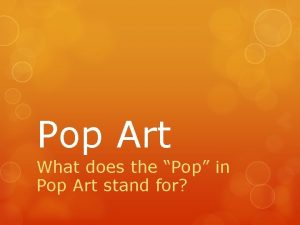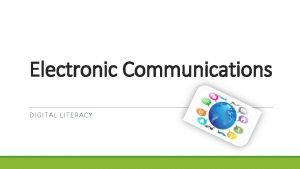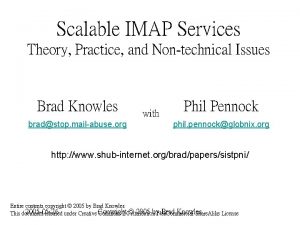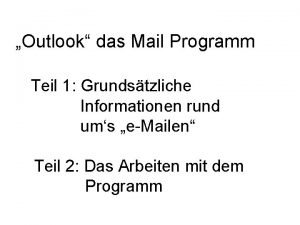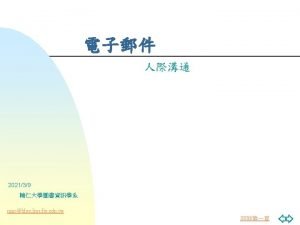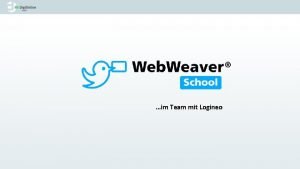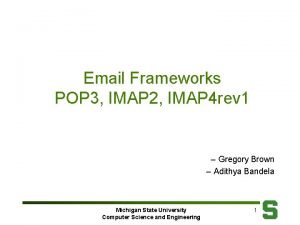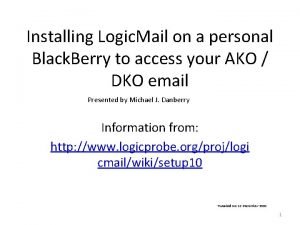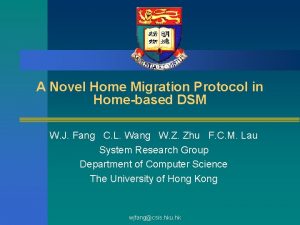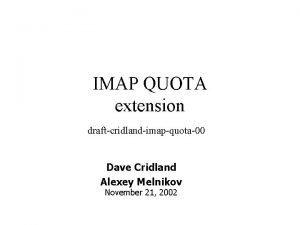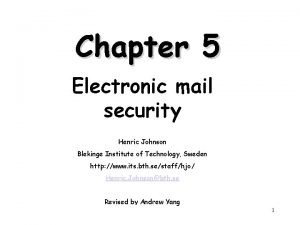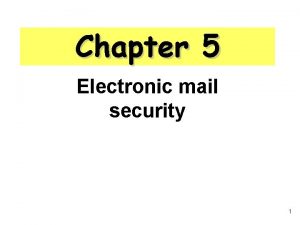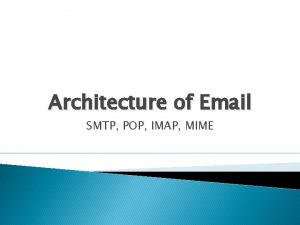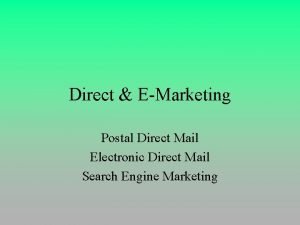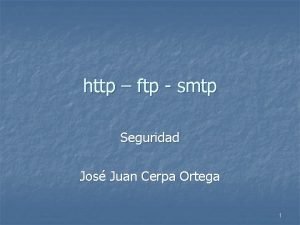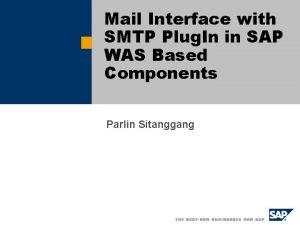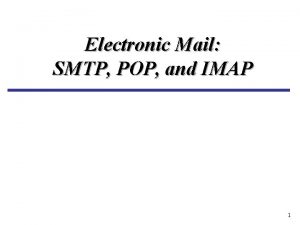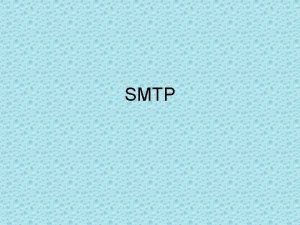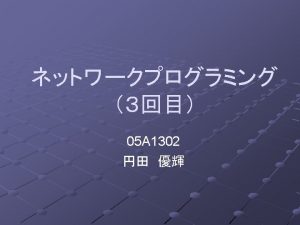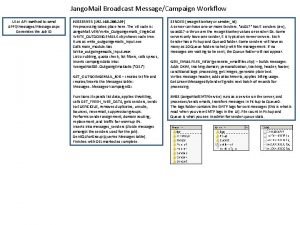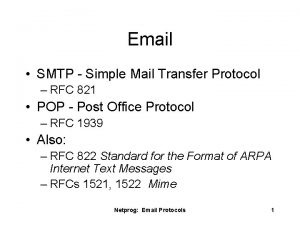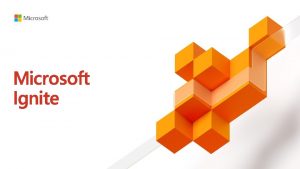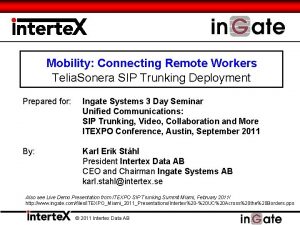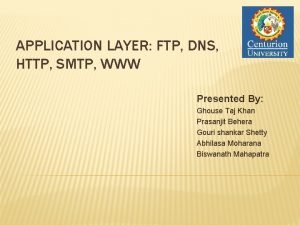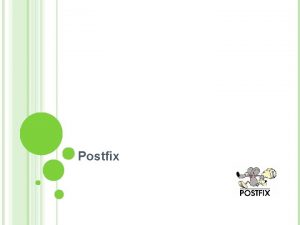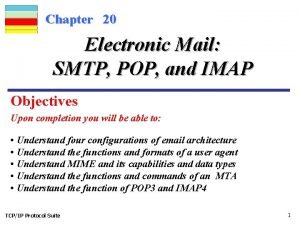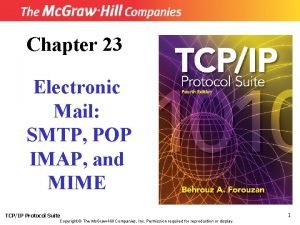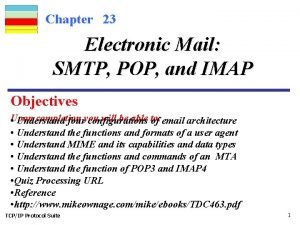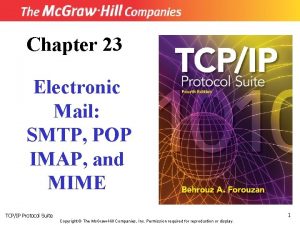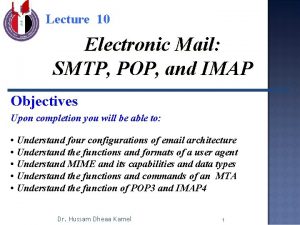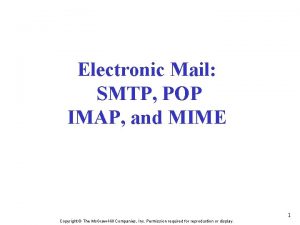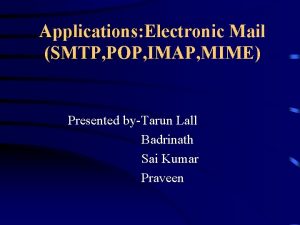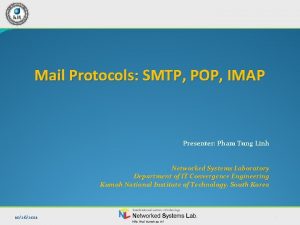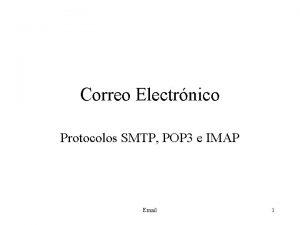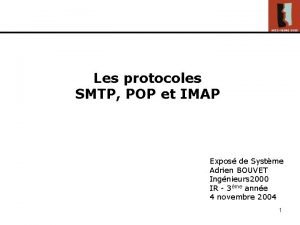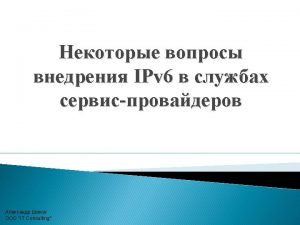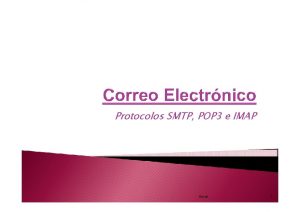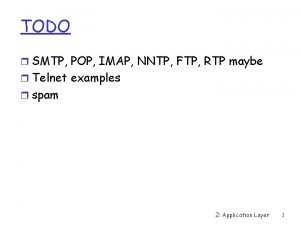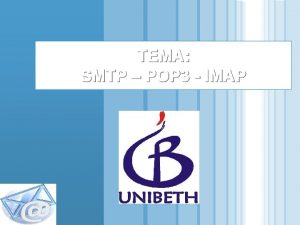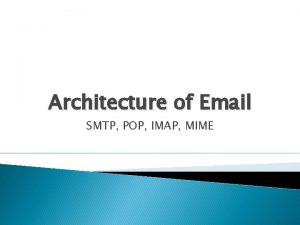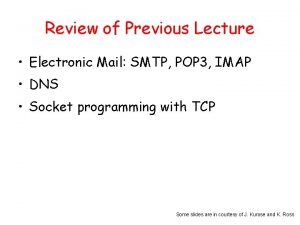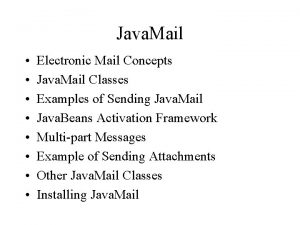Chapter 20 Electronic Mail SMTP POP and IMAP






































- Slides: 38

Chapter 20 Electronic Mail: SMTP, POP, and IMAP Objectives Upon completion you will be able to: • Understand four configurations of email architecture • Understand the functions and formats of a user agent • Understand MIME and its capabilities and data types • Understand the functions and commands of an MTA • Understand the function of POP 3 and IMAP 4 TCP/IP Protocol Suite 1

20. 1 ARCHITECTURE To explain the architecture of email, we give four scenarios. We begin with the simplest situation and add complexity as we proceed. The fourth scenario is the most common in the exchange of email. The topics discussed in this section include: First Scenario Second Scenario Third Scenario Fourth Scenario TCP/IP Protocol Suite 2

Figure 20. 1 TCP/IP Protocol Suite First scenario 3

Note: When the sender and the receiver of an email are on the same system, we need only two user agents. TCP/IP Protocol Suite 4

Figure 20. 2 TCP/IP Protocol Suite Second scenario 5

Note: When the sender and the receiver of an email are on different systems, we need two UAs and a pair of MTAs (client and server). TCP/IP Protocol Suite 6

Figure 20. 3 TCP/IP Protocol Suite Third scenario 7

Note: When the sender is connected to the mail server via a LAN or a WAN, we need two UAs and two pairs of MTAs (client and server). TCP/IP Protocol Suite 8

Figure 20. 4 TCP/IP Protocol Suite Fourth scenario 9

Figure 20. 5 TCP/IP Protocol Suite Push vs. pull 10

Note: When both sender and receiver are connected to the mail server via a LAN or a WAN, we need two UAs, two pairs of MTAs (client and server), and a pair of MAAs (client and server). This is the most common situation today. TCP/IP Protocol Suite 11

20. 2 USER AGENT The user agent (UA) provides service to the user to make the process of sending and receiving a message easier. The topics discussed in this section include: Services Provided by a User Agent Types Sending Mail Receiving Mail Addresses Mailing List MIME TCP/IP Protocol Suite 12

Figure 20. 6 TCP/IP Protocol Suite User agent 13

Note: Some examples of GUI-based user agents are Eudora, Outlook, and Netscape. TCP/IP Protocol Suite 14

Figure 20. 7 TCP/IP Protocol Suite Format of an email 15

Figure 20. 8 TCP/IP Protocol Suite Email address 16

20. 3 MESSAGE TRANSFER AGENT: SMTP The actual mail transfer requires message transfer agents (MTAs). The protocol that defines the MTA client and server in the Internet is called Simple Mail Transfer Protocol (SMTP). The topics discussed in this section include: Commands and Responses Mail Transfer Phases TCP/IP Protocol Suite 17

Figure 20. 13 TCP/IP Protocol Suite SMTP range 18

Figure 20. 14 TCP/IP Protocol Suite Commands and responses 19

Figure 20. 15 TCP/IP Protocol Suite Command format 20

Table 20. 4 Commands TCP/IP Protocol Suite 21

Table 20. 5 Responses TCP/IP Protocol Suite 22

Table 20. 5 Responses (Continued) TCP/IP Protocol Suite 23

Figure 20. 16 TCP/IP Protocol Suite Connection establishment 24

Figure 20. 17 TCP/IP Protocol Suite Message transfer 25

Figure 20. 18 TCP/IP Protocol Suite Connection termination 26

20. 4 MESSAGE ACCESS AGENT: POP AND IMAP The third stage of mail delivery uses a message access agent; the client must pull messages from the server. Currently two message access protocols are available: Post Office Protocol, version 3 (POP 3) and Internet Mail Access Protocol, version 4. The topics discussed in this section include: POP 3 IMAP 4 TCP/IP Protocol Suite 27

Figure 20. 19 TCP/IP Protocol Suite POP 3 and IMAP 4 28

Figure 20. 20 TCP/IP Protocol Suite POP 3 29

Figure 20. 9 TCP/IP Protocol Suite MIME 30

Figure 20. 10 TCP/IP Protocol Suite MIME header 31

Table 20. 1 Data types and subtypes in MIME TCP/IP Protocol Suite 32

Table 20. 1 Data types and subtypes in MIME (Continued) TCP/IP Protocol Suite 33

Table 20. 2 Content-transfer-encoding TCP/IP Protocol Suite 34

Figure 20. 11 TCP/IP Protocol Suite Base 64 35

Table 20. 3 Base 64 encoding table TCP/IP Protocol Suite 36

Figure 20. 12 TCP/IP Protocol Suite Quoted-printable 37

20. 5 WEB-BASED MAIL Some websites such as Hotmail and Yahoo provide email service to anyone who accesses the site. Mail transfer and retrieval requires the use of HTTP. TCP/IP Protocol Suite 38
 Atlas mail nastavení imap
Atlas mail nastavení imap Don would always open the mail throw away the junk mail and
Don would always open the mail throw away the junk mail and What does the pop in pop art stand for?
What does the pop in pop art stand for? What are the advantages and disadvantages of email
What are the advantages and disadvantages of email Electronic field production
Electronic field production Priority mail vs priority mail express
Priority mail vs priority mail express Google docshttps://mail.google.com/mail/u/0/#inbox
Google docshttps://mail.google.com/mail/u/0/#inbox Scalable imap
Scalable imap Hispeed imap einstellungen
Hispeed imap einstellungen Telnet imap
Telnet imap Courselets erstellen
Courselets erstellen Lernsax imap
Lernsax imap Imap diagram
Imap diagram Start logic email
Start logic email Imap hku
Imap hku Imap quota
Imap quota Imap terra outlook 2016
Imap terra outlook 2016 Kelebihan email dibanding surat biasa
Kelebihan email dibanding surat biasa E-mail singkatan dari? *
E-mail singkatan dari? * Electronic mail security in network security
Electronic mail security in network security Electronic mail security
Electronic mail security Electronic mail security
Electronic mail security Mime architecture
Mime architecture Electronic direct mail
Electronic direct mail Ftp and smtp
Ftp and smtp Is the electronic exchange of money or scrip
Is the electronic exchange of money or scrip Secure smtp control panel
Secure smtp control panel Mail.sap.corp
Mail.sap.corp Smtp vs snmp
Smtp vs snmp Smtp rfc 821
Smtp rfc 821 Smtp 220
Smtp 220 Jango email
Jango email маил
маил Smtp header analyzer
Smtp header analyzer Telia sip trunk
Telia sip trunk Ftp application layer
Ftp application layer Postfix transport map
Postfix transport map Osi model
Osi model Smtp onet
Smtp onet


